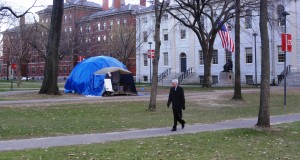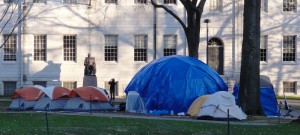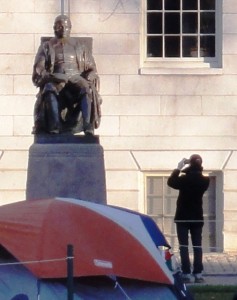“The Occuburg Address”: Occupy Harvard Marks Defeat
Posted by: Webmaster, in UncategorizedLast night I learned that Harvard’s “space occupants” — as I call the members of “Occupy Harvard” who have populated “Occuberg” on and off since November 9 — took down their tents yesterday, a day before their self-imposed deadline. They did it without advance notice of the time, in the wee morning hours when there were few if any non-occupants there to watch. To see what’s left of the site I stopped by this morning and took these photos of a suddenly barren landscape and, not unusual for “Occupy Harvard,” an info desk left vacant (click for full-screen detail):
Call me obsessive, but in addition to these photos taken from the west, east, southwest, and south, respectively, I snapped more photos of the former encampment from the north, northwest, west, and southeast (unfortunately the Hood blimp was unavailable for an aerial shot). I noticed that the vacant site left the security guards with plenty of time to chat (see here and here). Yet even with the tents gone and the site left vacant, each of the gates to Harvard Yard remained barred to those lacking Harvard i.d.s, as you can see from these photos of the north gate, south gate, east gate, and west gate (inside and outside).
Shortly after taking down the tents, on the OccupyHarvard.net website the space occupants — I guess that should be “former space occupants” — launched the latest salvo in their messaging war: a three-minute YouTube video expressing their feelings about some “naughty boys” at Harvard, which you can view here. I prefer more adult language, so using the sentiment behind the video I’ll term them “Harvard’s Most Hated.”
They are: Harvard government professor Harvey Mansfield, hated as a bigot and homophobe; Harvard history professor Niall Ferguson, also hated as a bigot, and a “slanted” cross-dressing economist, to boot; Harvard professor and former president, and former U.S. Treasury Secretary, Lawrence Summers, hated because some of his executive decisions yielded poor results, and because he used his financial background and connections to earn money; and the senior Fellow of the Harvard Corporation, and former U.S. Treasury Secretary, Robert E. Rubin, hated for the same reasons.
At 0:38 of the video, “Occupy Harvard” unveils its gifts to Harvard’s Most Hated for this holiday season: “Lumps of Coals for Naughty Boys!” Apparently there are no “naughty girls” at Harvard, not even Harvard president Drew Gilpin Faust, the person ultimately responsible for closing Harvard Yard during the occupation and thus depriving the space occupants of the reinforcements from outside Harvard they would have needed to sustain it.
Remarkably, even though “Occupy Harvard” prides itself on making decisions by consensus, in public, through regular “General Assembly” meetings, there was never any vote on whether any of these four individuals should be singled out and denounced by “Occupy Harvard” — the video simply appeared on the “Occupy Harvard” website without even a prior mention of the idea at any “General Assembly” meeting.
Although I wasn’t there yesterday morning and thus can’t personally vouch for the report, a source of mine reports that after the tents were all down, as the sun was coming up, one of the space occupants read some brief remarks off the back of an envelope. Later they were written up as a handout available at the info desk, which I’ve obtained. I haven’t yet seen it posted on the OccupyHarvard.net website (they haven’t even posted the pivotal resolution passed at the December 12 “General Assembly” meeting, though I’ve posted it, here), so I’ve taken the liberty of posting the text of the speech below.
The handout doesn’t list a title for the speech. Given that the members of the movement called their encampment “Occuburg,” it seems appropriate to call it “The Occuburg Address.” I give it high marks — solemn, dignified, concise; just right for this historic occassion.
Some of my commentators have suggested that the “Occupy” movement, at least in terms of its governance, is just a retread of previous failed consensus-obsessed “horizontal democracy” movements such as the Green Party and the Libertarian Party. I’m pleased to see that, with this speech marking the end of “Occupy Harvard 1.0,” the (former) space occupants have finally come up with something original.
(Note: I’ve added some hyperlinks to the text to provide some context for those who haven’t been reading this blog and OccupyHarvard.net. Also, I’ve changed around some archaic and sometimes confusing punctuation, but otherwise the text is as given to me by my source.)
–“Major Tom”
“The Occuburg Address”
Four score minus forty days ago our SEIU sponsors brought forth in this Harvard Yard, a tent city, conceived in consensus, and dedicated to the proposition that all janitors are created equal.
Now we are engaged in a great messaging war testing whether that city, or any city so conceived, can long endure. We are met on a great battlefield of that war. We have come to dedicate a geodesic dome, as a final resting place for the dreams of labor activists who slept here so that that city might live. It is altogether fitting and proper that we should do this.
But in a larger sense, we cannot dedicate — we cannot consecrate, we cannot hallow — this dome. The space occupants, women and men, who occupied here have consecrated it far above our poor power to add or detract.
The world will little note nor long remember what we say here, but it can never forget what they did here. It is for us the non-occupying, rather, to be dedicated here to the unfinished work which they who slept here have thus far so nobly advanced.
It is rather for us to be here dedicated to the great task remaining before us — that from this honored dome we take increased devotion to that cause for which the space occupants gave the last full measure of devotion — that we here highly resolve that these occupants shall not have occupied in vain — and that this city, under Bok, shall have a new birth of freedom — and that government of consensus, by consensus, for consensus, shall not perish from the earth.












 Entries (RSS)
Entries (RSS)